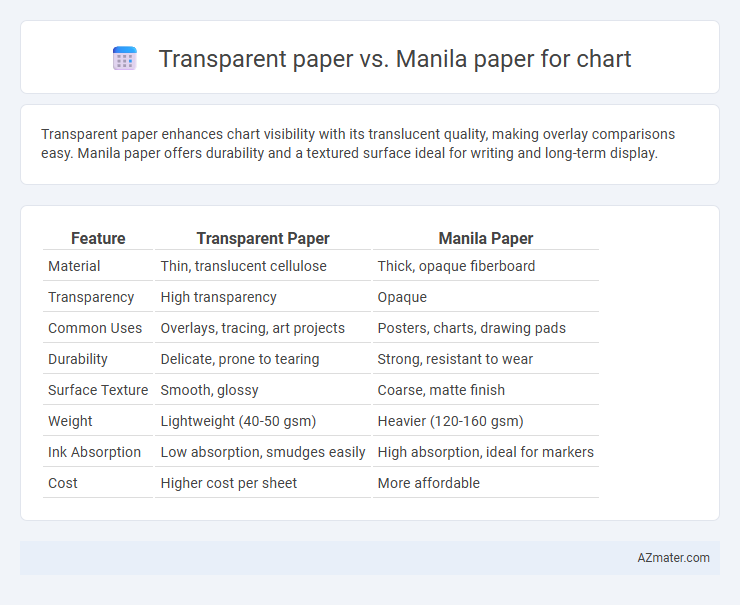Transparent paper enhances chart visibility with its translucent quality, making overlay comparisons easy. Manila paper offers durability and a textured surface ideal for writing and long-term display.
Table of Comparison
| Feature | Transparent Paper | Manila Paper |
|---|---|---|
| Material | Thin, translucent cellulose | Thick, opaque fiberboard |
| Transparency | High transparency | Opaque |
| Common Uses | Overlays, tracing, art projects | Posters, charts, drawing pads |
| Durability | Delicate, prone to tearing | Strong, resistant to wear |
| Surface Texture | Smooth, glossy | Coarse, matte finish |
| Weight | Lightweight (40-50 gsm) | Heavier (120-160 gsm) |
| Ink Absorption | Low absorption, smudges easily | High absorption, ideal for markers |
| Cost | Higher cost per sheet | More affordable |
Introduction to Chart-Making Materials
Transparent paper offers clarity and durability, making it ideal for overlaying detailed data and complex designs in chart-making, while Manila paper provides a sturdy, affordable surface that holds markers and paints well for bold, vibrant presentations. The choice between transparent and Manila paper impacts readability, transparency, and the overall visual effectiveness of charts in educational and professional settings. Selecting the right material depends on the specific needs of the chart, such as layering requirements, presentation style, and durability.
What is Transparent Paper?
Transparent paper, often known as tracing paper, is a semi-transparent, smooth paper that allows light to pass through, making it ideal for overlaying charts and diagrams. It is widely used for precise drafting and detailed chart work, as its translucency helps in accurate tracing and layering of information without obscuring underlying details. In comparison, manila paper is opaque and thicker, primarily used for bold displays and bulkier chart presentations rather than fine, transparent overlays.
What is Manila Paper?
Manila paper is a durable type of paper made from Manila hemp, known for its light brown color and sturdy texture, often used for charts, posters, and envelopes. Its thick, absorbent surface allows markers and paints to adhere well, making it ideal for presentations and educational materials. Compared to transparent paper, Manila paper provides better visibility and a tactile feel, enhancing the clarity and impact of visual content on charts.
Physical Properties Comparison
Transparent paper offers high translucency and smooth surfaces ideal for overlays and detailed charts requiring clarity, while Manila paper features a coarser texture and higher opacity, providing durability and rigidity suitable for heavier handling. The tensile strength of Manila paper generally exceeds that of transparent paper, making it more resistant to tearing during frequent use. Moisture resistance is higher in transparent paper due to its polymer coating, which helps prevent warping and smudging in humid environments compared to the more absorbent Manila paper.
Visual Clarity and Presentation
Transparent paper offers superior visual clarity for charts by allowing underlying layers and colors to show through, enhancing depth and detail in presentations. Manila paper provides a solid, opaque background that ensures bold, vibrant visuals but may lack the nuanced translucency needed for multi-layered data display. Choosing transparent paper improves the readability of overlapping elements, while manila paper excels in delivering strong contrast and durability for straightforward chart presentations.
Durability and Longevity
Transparent paper offers limited durability and tends to degrade faster under frequent handling and exposure to environmental factors, making it less ideal for long-term chart displays. Manila paper, known for its sturdier fiber composition and resistance to tearing, provides enhanced longevity and retains structural integrity over extended periods. Charts created on Manila paper maintain their readability and appearance better in both classroom and professional settings.
Ease of Use for Drawing and Writing
Transparent paper offers a smooth surface that facilitates precise drawing and clear writing, ideal for detailed charts and overlays. Manila paper provides a sturdy, textured surface that supports bold marker use but may cause ink to bleed slightly, affecting fine details. For ease of use in drawing and writing, transparent paper enables cleaner lines and better visibility of underlying references, enhancing accuracy.
Cost and Availability
Transparent paper typically costs more than Manila paper due to its specialized manufacturing process and limited production scale. Manila paper is widely available and budget-friendly, making it the preferred choice for large-volume chart printing and educational purposes. Cost-effectiveness and easy accessibility position Manila paper as the more practical option for everyday chart creation.
Best Use Cases for Each Paper Type
Transparent paper excels in presentations requiring overlays and detailed visual layering, making it ideal for project planning, architectural drafts, and graphic design charts. Manila paper offers durability and a textured surface suited for group brainstorming sessions, educational charts, and wall displays that demand frequent handling or annotation. Choosing transparent paper enhances clarity and precision, while manila paper supports collaborative engagement and repeated use.
Conclusion: Which is the Better Choice for Charts?
Transparent paper offers superior clarity and allows for layering effects that enhance visual depth in charts, making it ideal for presentations requiring detailed overlays. Manila paper provides a sturdy, opaque surface that supports vibrant, easy-to-read markings, best suited for charts needing durability and clear color contrast. Choosing between the two depends on whether transparency and layering or robustness and visibility are the primary needs for the chart's application.

Infographic: Transparent paper vs Manila paper for Chart
 azmater.com
azmater.com